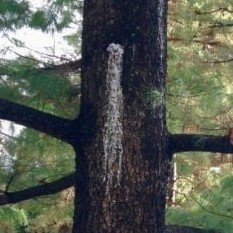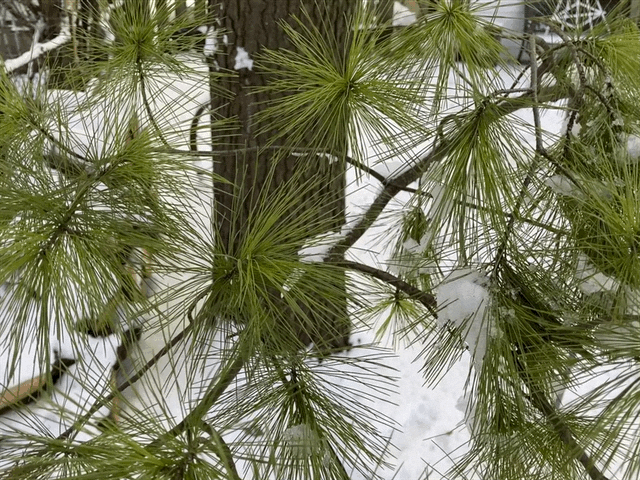Oh White Pine!
It’s that time of year when many people get festive and decorate their homes with boughs, pine tree sprays and pinecones; essentially bringing the outdoors inside. But did you ever think about the nutritional and medicinal value of pine trees? It is a great time of year to take advantage of the immune-supporting properties of the evergreens. I am going to focus on the White Pine (Pinus strobus) and discuss some ways we can utilize this pine for our health and not just as decoration.
The white pine is common in the eastern part of the United States, it is found from Maine south to Georgia and west to the Mississippi River. Its majestic height makes it the largest pine species in the eastern part of the US, growing to be as tall as 80 feet and as wide as 40 feet. The needles are soft and feathery with hues ranging from bluish green to lime green. They are arranged in clusters of 5 and densely crowded near the ends of the horizontal branches. The needles tend to be thin and about 4-6 inches long. They remain on the tree for 2-3 years before dropping in the fall season.
The white pine bears both male and female cones. The male cones are small, produce pollen and are found in clusters at the tips of the branches. The female cones are more showy, slender, and grow downward. They can grow up to 8 inches long. After fertilization, the female cones (which contain seeds and are considered mature) will drop to the ground. Once they open and release their seeds, the cones are often used for decoration because of the attractive white resin tips that contrast against the brown cone.
Now that we have gotten some white pine facts out of the way, let’s talk about how we can utilize the medicinal and nutritional qualities of this beautiful evergreen. The needles contain high amounts of vitamin C, flavonoids (including certain polyphenols) and terpenes. The easiest way to take advantage of these nutrients is to make a tea from the needles. Since vitamin C can be destroyed if the needles are boiled too long, please consult the recipe below taken from Cindy Halbkat of Wild Edible on how to properly make pine needle tea.
White Pine Tea
Yield: 3 cups
Ingredients: 1/2 cup white pine needles, chopped or cut with scissors into 1/2-inch lengths
3 cups water
Instructions: Bring water to a simmer in a stainless-steel pan. Add pine needles. remove from heat and let steep for 15 to 20 minutes.
For a stronger tea, keep at a simmer for 20 minutes and remove from heat. Then cover and let sit overnight. Strain pine needles, sweeten to taste if preferred, and serve tea hot or cold.
Notes: Make sure not to boil the pine needles to preserve vitamin C and prevent the release of bitter terpenes.
Vitamin C not only plays an important role in supporting strong immunity but also helps with tissue repair, scurvy, and proper nervous system function. The human body cannot make vitamin C on its own, so we need to consume foods that contain it; and we need to consume it often. Since vitamin C is a water-soluble vitamin, it gets used quickly by the body.
The polyphenols found in white pine needles can assist in repair of damaged skin and help with collagen formation leading to better skin elasticity. More importantly polyphenols also reduce oxidative stress, which improves the overall health of the body.
Terpenes are aromatic molecules found in the needles. An example of a terpene is pinene which gives pines their characteristic scent. Pinene helps to promote respiratory health. The essential oil of white pine can be used as a decongestant and an expectorant. It can also be used in a diffuser to cleanse the air.
Another part of the white pine that can be utilized is the resin. White pine resin can be found on pinecones but it can also come from a wounded trunk or damaged branches. This resin can be collected, heated gently and used to help heal wounds, infections and burns by applying it where it is needed. It is very anti-microbial and anti-inflammatory; it is essentially the life blood of the tree. I do not recommend damaging the tree to access the resin as you can find plenty on the cones.
I am going to defer to Scott Sexton from The Grow Network who has some great ideas on what parts of the white pine are edible (I must confess that I have not tried most of these). For example, Scott suggests collecting the pollen from the male cones, then taking 1 spoonful a day as well as eating the male cones for immune strengthening purposes. These suggestions and the nutritional worth are both amazing and interesting! Please click HERE to learn more.
I think one of the most therapeutic properties about the white pine is the auditory therapy that the tree can provide; to simply sit under or around it and listen to the wind blowing through the soft needles.



